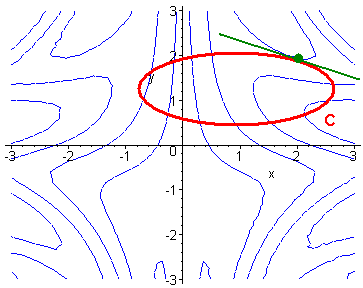Lagrange Multipliers
Lagrange Multipliers
Suppose that we have a function f(x,y) that we want to maximize in the restricted
domain g(x,y) = c for some constant c. Then we can look at the level curves of
f and seek the largest level
curve that intersects the curve g(x,y) = c. It is not hard to see that
these curves will be tangent. Hence the gradient vectors will be parallel.

|
Theorem |
Example:
Find the extrema of
f(x,y) = x2 - y2
subject to
the constraint
y - x2 = 0
Solution:
We have
F(x,y) = (x2 - y2) - l
(y - x2)
Now take partial derivatives and set them equal to zero:
Fx(x,y) = 2x - l2x = 0
Fy(x,y) = -2y - l = 0
This gives us the three equations:
2x = -l2x,
-2y = l(1),
and y - x2 = 0
the first equation gives us (for x nonzero)
l = -1
Hence the second equation becomes
-2y = -1
so that
y = 1/2
the third equation gives us
1/2 - x2 = 0
Hence
x =
![]() /2
/2
For x = 0, we see that y =
0. Hence the two possible local extrema
are
(![]() /2,1/2)
and (0,0)
/2,1/2)
and (0,0)
Plugging into f(x,y), we see that
f(![]() /2,1/2) = 1/4
/2,1/2) = 1/4
and
f(0,0) = 0
Hence 1/4 is the local maximum and 0 is the local minimum.
Example 2
Find the distance from the origin to the surface
xyz = 8
Solution
We minimize
D = x2 + y2 + z2
subject
to the constraint
xyz = 8
We have
F(x,y) = ( x2 + y2 + z2) - l
(xyz)
Now take partial derivatives and set them equal to zero:
Fx(x,y) = 2x - lyz = 0
Fy(x,y) = 2y - lxz = 0
Fz(x,y) = 2z - lxy = 0
Which give the four equations
2x = l
yz, 2y = lxz,
2z =
lxy, xyz = 8
or
l
= 2x/yz = 2y/xz = 2z/xy xyz
= 8
or
2x2 = 2y2 = 2z2
xyz = 8
Hence
x = ± y = ± z
Plugging into the last equations gives
±x3 = 8
or x = ±2
We get the points
(2,2,2), (2,-2,-2), (-2,-2,2),
(-2,2,-2)
these all have distance
![]() from the origin.
from the origin.
Two Constraints
Example:
Maximize
x2 + y2 + z2
on the intersection of the two surfaces:
xyz = 1
and x2 +
y2 + 2z2 = 4
Solution:
When there are two constraints we use
F(x,y,z) = f(x,y,z) - ag(x,y,z) + bh(x,y,z)
and find the critical points of F. We get
F(x,y,z) = (x2 + y2 + z2) - a(xyz) - b(x2 + y2 + 2z2)
and take partial derivatives
Fx = 2x - ayz - b2x
Fy
= 2y - axz - b2y
Fz
= 2z - axy - b4z
which gives the five equations
2x = ayz +
2bx, 2y = axz + 2by, 2z =
axy + 4bz,
xyz = 1, and
x2 + z = 1
Multiply the first equation by x, the second by
y and the third by z to
get
2x2 = axyz + 2bx2,
2y2 = axyz + 2by2, 2z2
= axyz + 4bz2,
Solving each for axyz gives
axyz = 2x2 - 2bx2
= 2y2 - 2by2 = 2z2 - 4bz2
This gives that
2x2(1 - b) = 2y2(1
- b) = 2z2 (1 - 2b)
This first equality gives
x = ±y
Using the last of the original equations to solve for x2 gives
x2 = 1 - z
Substituting and dividing by 2 gives
(1 - z)(1 - b) = z2
(1 - 2b)
Using xyz = 1 and substituting gives
±(1 - z)z = 1
so
z2 - z + 1 = 0 or z2 + z - 1 = 0
The first has no solution and the second has solutions
z = -1/2
± 1/2 ![]()
Now

and

Back to the Math 117 Home Page
Back to the Math Department Home
e-mail Questions and Suggestions